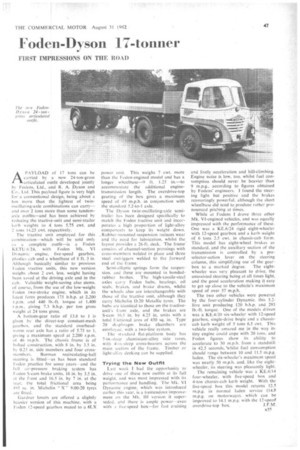roden-Dyson 17-tonner
Page 49

If you've noticed an error in this article please click here to report it so we can fix it.
FIRST IMPRESSIONS ON THE ROAD
APAYLOAD of 17 tons can he carried by a new 24-ton-gross articulated outfit developed jointly by Fodens, Ltd., and R. A. Dyson and Co., Ltd. This payload figure is very high for a conventional design, being about a ton more than the lightest of twinosei Ilan ng-axle combinations can carry— and over 2 tons more than some tandemaxle outfits—and has been achieved by reducing the tractive-unit and semi-trailer kerb weights to 4 tons 5.75 cwt. and 2 tons 14.25 cwt. respectively.
The tractive unit employed for this combination—which will be sold only as a complete outfit—is a Foden KETU.6.24, with Foden Mk. VI Dynamic engine, five-speed gearbox, plastics cab and a wheelbase of 8 ft. 3 in. Although basically similar to previous Foden tractive units, this new version weighs about 2 cwt. less, weight having been saved at the driving axle and in the cab. Valuable weight-saving also sterns. of course, from the use of the low-weight Foden two-stroke engine. which in its latest form produces 175 b.h.p. at -2,200 r.p.m. and 440 lb-ft. torque at 1,400 r.p.m., giving 7.3 b.h.p. per ton gross weight at 24 tons gross.
A bottom-gear ratio Of 13,8 to 1 is given by the direct-top Constant-mesh Learbnx. and the standard overheadworm rear axle has a ratio of 5.75 to 1. Living a maximum speed at 2,200 r.p.m. of 46 m.p.h. The chassis frame is of bolted construction, with 8 in. by 3.5 in. by 0.25 in. side members and four crossmembers. Burman recirculating-ball steering is fitted—as has been standard Foden practice for some years—and the full air-pressure braking system has Foden S-cam brake units. 16 in. by 3.5 in, at the front and 16.5 in. by 7 in. at the rear, the total frictional area being 493 sq. in. Michelin " X" 9.00-20 tyres are fitted.
Gardner lovers are offered a slightly heavier version of this machine, with a Foden I2-speed gearbox mated to a 6LX
power !Init. This weighs 7 cwt. more than the Foden-engined model and has a
longer wheelbase-9 ft. 1.25 in.—to accommodate the additional enginetransmission length. The overdrive-top gearing of the box gives a maximum speed of 49 m.p.h. in conjunction with the standard 5.2-to-1 axle.
The Dyson twin-oscillating-axle semitrailer has been designed specifically to match the Foden tractive unit and incorporates a high proportion of light-alloy components to keep its weight down. , Rubber-mounted suspension reduces wear and the need for lubrication, whilst the layout provides a 26-ft. deck. The frame consists of channel-section pressings with cross-members welded in place and three steel outriggers welded to the forward end of the frame.
Semi-elliptic springs form the suspension, and these are mounted in bondedrubber bushes. The high-tensile-steel axles carry Foden hubs, bearings, oil seals, brakes, and brake drums, whilst the wheels also are interchangeable with those of the tractive unit, Although they carry Michelin D.20 Metallic tyres. The hubs are identical to those on the tractiveunit's front axle, and the brakes are S-cam 16.5 in. by 4.25 in. units with a total frictional area of 450 sq. in. Type 20 diaphragm brake chambers are ernoloyed. with a two-line system.
The standard flat-platform body has 7-in.-deep aluminium-alloy side raves, with 4-in.-deep cross-bearers across the main section of the frame. Timber or light-alloy decking can be supplied.
Trying the New Outfit Last week I had the opportunity to drive one of these new outfits at its full weight. and was most impressed with its performance and handling, The Mk. VI Dynamic engine, which was introduced earlier this year, is a tremendous improvement on the Mk. III version it superseded, and there is ample power—even with a live-speed box—for fast cruising and lively acceleration and hill-climbing. Engine noise is low, too, whilst fuel consumption should never be heavier than 9 m.p.g., according to figures obtained by Fodens' engineers. I found the steering light but positive and the brakes reassuringly powerful, although the short wheelbase did tend to produce rather pronounced pitching at times.
While at Fodens I drove three other Mk. V1-engined vehicles, and Was equally impressed with the performance of these. One was a KE.6,/24 rigid eight-wheeler with I2-speed gearbox and a kerb weight of 6 tons 2.5 cwt. in chassis-cab form. This model has eight-wheel brakes as standard, and the auxiliary section of the transmission is controlled by a preselector-action lever on the steering column, this simplifying use of the gear box to a marked degree. The eightwheeler was very pleasant to drive, the unassisted steering being at all times light, and the good acceleration making it easy to get up close to the vehicle's maximum
speed of over 57 ' The two other vehicles were powered by the four-cylinder Dynamic. this 3.2litre unit producing 120 b.h.p. and. 293 lb.-ff. torque. One of the models driven was a KE.4./20 six-wheeler with 12-speed gearbox, single-drive bogie and a chassiscab kerb weight of 5 tons 6.5 cwt. This vehicle really amazed me in the way its tiny engine could cope with 20 tons. and Foden figures show its ability to accelerate to 30 m.p.h. from a standstill in 42.5 seconds, 'Whilst fuel consumption should range between 10 and 11.5 m.p.g. laden. The six-wheeler's maximum speed was nearly 50 m.p.h. and, like the eightwheeler, its steering was pleasantly light.
The remaining vehicle was a KE.4/14 fonr-wheeler, with five-speed box and 4-ton chassis-cab kerb weight. With the five-speed box this model returns 12.5 m.p.g. in normal laden service (14.8 m.p.g. on motorways). which can he improved to 14.1 m.p.g. with the 12-speed overdrive-top box.




























































































